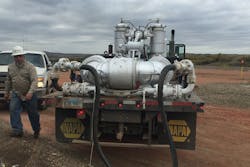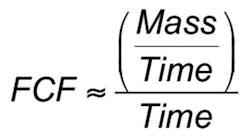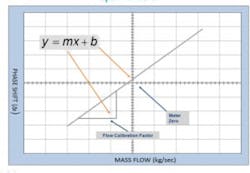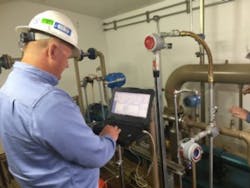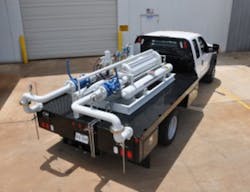The perfect flow meter, as described by George Mattingly, Ph.D., of the National Institute of Standards and Technology (now retired), never drifts or wears. It never needs zeroing and measures in mass units. It is immune to the effects of changing fluid properties and fluid dynamics, density, viscosity, Reynolds number, speed of sound, swirl and irregular flow profile. It has virtually zero pressure drop. It features advanced diagnostics capable of thoroughly checking any abnormal conditions, perhaps sending text messages to relevant stakeholders to provide advanced notice and guidance on how to remedy the condition. Finally, it is accepted by the governing/legal bodies in all industries.
Flow meter technologies are not there yet, but Coriolis technology is getting pretty close with increasingly powerful diagnostics.
The first article in this two-part series on Coriolis flow meter calibration and verification discusses Coriolis flow meter calibration basics, theory of operation, verification and calibration paradigms. It also considers third-party agency/regulator recognition and case studies in which verification techniques identified meter damage and accuracy issues. Part 2 will focus on third-party recognition and present several case studies where verification techniques detected corrosion, erosion, coating and over-pressure, concluding with commentary on the future direction for verification research.
Coriolis basics
Before understanding the basics of verification, it is useful to comprehend the basics of how a Coriolis flow meter works. The meter directly measures the mass flow rate of a fluid by vibrating (driving) a fluid-conveying tube at resonance. A common geometry for high-performance Coriolis flow meters is the dual "U" tube shown in Figure 1. The flow enters from the pipeline and is split by the inlet manifold into the two U-shaped flow tubes. The flow is then rejoined at an outlet manifold and continues down the pipeline.
Figure 1. Internal flow tubes in a flow meter
The meter is driven like a tuning fork. Coriolis forces are generated by the cross product of the mass flow and the tube motion. These forces act on the tubes to give rise to a time delay between inlet and outlet. The time delay between two locations is called dt, and is directly proportional to mass flow rate.
The amount of dt is dependent on the magnitude of the Coriolis forces and the stiffness of the flow tubes. For a given tube shape and mass flowrate, the Coriolis forces are constant. The dt therefore depends on the stiffness of the flow tubes, an important factor in verification techniques discussed in that context later in this article. The mass flow rate measurement is related to the dt by the flow calibration factor, which is discussed in the next section.
This equation shows that the derived units of the flow calibration factor (FCF) are mass flow rate/time delay:
FCF = m
dt
This is shown dimensionally using fundamental physical units as:
Density measurement
Coriolis meters also independently measure the density of the process fluid by accurately measuring the resonant frequency of the drive mode. The resonant frequency is a function of the stiffness of the flow tubes and the mass of the flow tubes, which includes the mass of the steel of the flow tubes plus the mass of the fluid with the tubes.
Note that the resolution of the density signal is generally not adequate for accurate/meaningful gas density. Other vibrating element technologies are optimized for this measurement.
Volumetric flow rate & concentration measurement
Most other flow meter technologies produce volumetric flow as the raw output, which is typically converted into a standard volume. Note that standard volume is closely related to total mass. Coriolis flow meters can also produce a standard volume output using either the instantaneous density as measured by the Coriolis flow meter, a standard or sampled density, or a calculated density based on process conditions. Standard or reference density is used with pure fluids.
Measured density can be correlated to percent concentration, such as that of an acid, base or catalyst. Coriolis meters are sometimes referred to as process analyzers if the fluid is or behaves as a binary system.
Flow meter certification
Calibration, proving, verification and validation are sometimes used interchangeably, but important differences and a hierarchy exist between them. Calibration and recalibration are presented and discussed in the September 2015 Flow Control article by Jesse Yoder, Ph.D. Validation often refers to a process or system such as a pharmaceutical process, but it can also mean confirming flow performance by comparing a primary flow standard to meter under test.
Proving generates a meter factor, whereas calibration compares flow meter performance to a national or international reference — typically a weigh scale or master meter. The meter’s output is compared and adjusted to match the reference. These reference or transfer standards should be certified by an agency such as ISO 17025 to determine system accuracy.
A common industrial rule of thumb holds that the reference must be three to five times more accurate than the device being tested or calibrated. For example, a Coriolis flow meter claiming 0.1 percent mass flow accuracy must be calibrated on a system with at least 0.03 percent mass flow performance as accredited by a third-party agency, audited by a group such as the National Voluntary Laboratory Accreditation Program, Singapore Accreditation Council or Emirates National Accreditation Systems.
Verification establishes confidence in meter accuracy by analyzing secondary variables correlated with primary flow measurement. Verifications typically give a yes or no result. They are generally not used to adjust the calibration or meter factor, and are often viewed as less precise than the meter itself. Verification techniques strive to provide early notice that something may have shifted in the meter, justifying more investigation. An additional goal is to provide cost-effective data more frequently than calibration checks or proving. Some users report running meter verification daily to generate a robust audit trail.
In all of this, examine potential sources of meter inaccuracy, including meter zero; meter span factor; configuration settings for output; and any receiving device used for totalization, such as a programmable logic controller or distributed control system. Figure 2 shows the relationship between zero and span. At least one Coriolis vendor offers an advanced zero verification tool to assist the user in determining when and if the meter should be rezeroed, and if process conditions are stable enough to yield a good zero value.
A paradox & conundrum
Figure 2. Chart showing meter zero, where m = span factor and b = meter zero
As a technology, Coriolis flow meters are extremely accurate and stable over time. Customers often apply calibration work practices developed from legacy technologies known to wear and drift. Positive displacement and turbine flow meters are good examples of this because they are very accurate when maintained properly but known to wear and shift, especially with abrasive or dirty fluids. Flow meter users are sometimes bound by regulators with legacy or out-of-date standards based on traditional technologies, which can lead to low-value or expensive results and challenging use of precious high-skill technicians and engineers.
The paradox and conundrum is that although substantial data exists to demonstrate the Coriolis flow meter’s resistance to impacts from corrosion, erosion or overpressure, recalibration or proving continues with very little value because the meter has not changed. In many applications, either a standard work practice or regulation requires recalibration or proving at certain intervals regardless of the actual performance of the meter.
Verification can replace some, if not all, "wet" calibrations. At a minimum, its data can augment proving or calibration for industry segments that require more long-term proof of concept. The process can be performed more affordably and frequently than proving or calibration, and it adds to the data set, further boosting measurement confidence. This requires a paradigm adjustment.
Meter verification case study
A service technician performs meter verification.
Verification diagnostic techniques have rapidly advanced over the last five to 10 years and are continuing to improve. For example, six meters are used in cavern storage of hydrocarbons in western Canada and were regularly proved, with some random variation in meter factor but no statistical change. More than $175,000 was spent on these provings.
As a result of data such as this, Alberta, Canada’s energy regulator created Directive 17, which states:
If a meter has built-in diagnostics to continuously monitor the condition of the primary element, inspection is not required until an alarm or error is generated by the meter or as recommended by the manufacturer, such as in some types of Coriolis meters.
By using meter verification, proving may be extended until the onboard diagnostics advise it is time to prove. This will result in significant savings in proving costs during these extended proving intervals. Some of the meters in this application were upgraded to have modern diagnostics.
Several different Coriolis verification methodologies are available. Some are vendor independent, such as the known-density method, while others are proprietary. Some require stopping the flow or stopping the process measurement to perform the verification. Others are more time consuming and may require a hot-work permit. Some can be done in situ without stopping flow or the flow measurement.
Verification methodologies can include measuring and trending process measurements, looking at internal parameters such as drive gain and pickoff amplitude, and using additional hardware internal or external to the transmitter to verify flow measurement. The user can perform many of these techniques, and others require a service technician visit by the vendor.
A strong need exists for verification techniques to check electromechanical and electronic hardware changes, transmitter configuration changes, digital or analog output hardware and configuration, and zero changes. Some of the verification techniques can do most or all of these checks.
A detailed discussion of four different stiffness-based verification techniques is presented and a comparison/contrast of their similarities and differences in Reference 1. This focus on stiffness based techniques is important because of the previously described relationship between the flow calibration factor and stiffness.
Back to the ‘perfect’ flow meter
A truck-mounted compact prover
The perfect flow meter — zero calibrations, zero proving, no zeroing, zero worries with powerful diagnostics that can verify meter accuracy and give advance warning of changes — does not yet exist. Coriolis flow meters, however, are largely insensitive to fluid properties. The author predicts that within 10 years, on-board meter verification diagnostics will be a standard expectation in Coriolis technology. Verification will not replace proving or calibration, but it can, and is already, extending intervals. Proving and calibration are often regulated by legal and contractual arrangements. Verification is recognized by a growing number of agencies.
Verification techniques can provide an end-to-end check of the flow measurement system. They look at a secondary set of variables to verify calibration and should check configuration, span and zero. Span factor verification techniques vary, but meter tube integrity is essential. These verifications are much easier, cheaper and quicker than proving and can be performed remotely. They can be performed more frequently to generate statistical confidence and applied in flow meter or process troubleshooting.
Reference
1. Cunningham, T. In Situ Verification of Coriolis Flowmeters, Paper #13-0148, CsHm 2013, Calgary, AB Canada.
Tom O’Banion is the director of industry differentiation at Micro Motion Inc., a business unit of Emerson Process Management. He has more than 30 years of experience with Coriolis flow meter technology and holds a bachelor’s degree in chemical engineering from the University of Colorado Boulder and an MBA in energy management from the University of Denver. He is a member of the Flow Control Editorial Advisory Board, as well as Flow Research’s Flow Meter Recalibration Working Group. He may be reached at [email protected].
